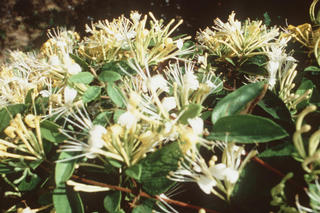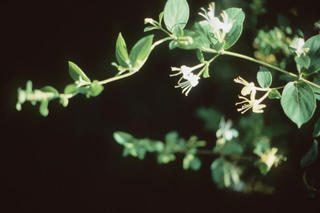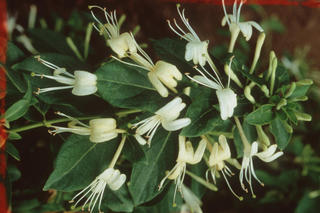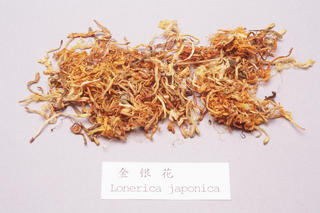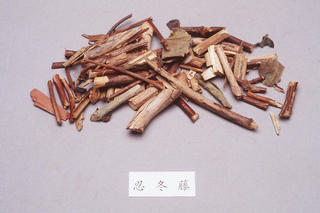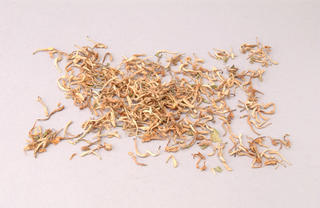Lonicera japonica
Contents
- 1 Nomenclature
- 2 Historical Use of Lonicera japonica
- 3 Background
- 4 Nomenclature
- 5 Historical Use of Lonicera japonica
- 6 Background
- 7 Nomenclature
- 8 Historical Use of Lonicera japonica
- 9 Background
- 10 Nomenclature
- 11 Historical Use of Lonicera japonica
- 12 Background
- 13 Nomenclature
- 14 Historical Use of Lonicera japonica
- 15 Background
- 16 Nomenclature
- 17 Historical Use of Lonicera japonica
- 18 Background
- 19 Nomenclature
- 20 Historical Use of Lonicera japonica
- 21 Background
- 22 Nomenclature
- 23 Historical Use of Lonicera japonica
- 24 Background
- 25 Pharmaceutical Information
- 26 Evidence or the Use of Lonicera japonica in the Treatment of Epilepesy
- 27 Safety
Nomenclature
Other Names:
Historical Use of Lonicera japonica
Lonicera japonica in Traditional Chinese Medicine
Background
Chinese Name (pinyin): Rendongteng
Chinese Name :
Common Name :Honeysuckle Stem
Specific Name : Caulis lonicerae
Scientific Name:
Collection : The drug is collected in autumn and winter and dried in the sun.
Description : Long cylindrical, frequently branched, usually twisted into a bundle, 1.5-6gmm in diameter, externally brownish-red to dark brown, some greyish green, glabrous or pubescent, outer bark easily fallen off. Branches muchnodose, internodes 6-9cm long, showing remains of the leaves and leaf scars. Texture fragile, easily broken fracutre yellowish-white, hollow, odourless, taste of older branches, slightly bitter and the younger ones, weak.
Identification :
Processing : Eliminate foreign matter, wash clean, cover to soften, cut into sections and dry.
Action : To remove toxic heat, and to dispel wind from the channels and collaterals.
Indication : epidemic febrile diseases, acute dysentery, carbuncles, sores, acute arthritis with redness, swelling and pain of the joint
Precautions :
Dosage : 9 to 30 g.
Storage : Preserve in a dry place.
Nomenclature
Other Names:
Historical Use of Lonicera japonica
Lonicera japonica in Traditional Chinese Medicine
Background
Erbaohua ¶þ±¦»¨
Rendonghua È̶¬»¨
Shuanghua Ë«»¨
Yinhua Òø»¨
Chinese Name (pinyin): Jinyinhua
Chinese Name :
Common Name :Honeysuckle Flower
Specific Name : Flos lonicerae
Scientific Name:
Collection : The drug is collected before flowering in summer and dried or dried after fumigating with sulfur.
Description : Flower of Lonicera Japonica: clavate, stout in the upper part and tapered downwards, slightly curved, 2 - 3cm long, about 3mm in diameter in upper part 1.5mm in diameter in lower part. Externally yellowish white or greenish white, gradually darken on keeping, densely pubescent, foliaceous bracts occasionally visible, calyx green, 5 lobed at the apex, lobes pubescent, about 2mm long. Corolla tubular when open, apex 2 lipped, stamens 5, epipetalous, yellow, pistil 1, ovary glabrous, odour delicately aromatic, taste weak and slightly bitter.Flower of Lonicera Hypoglauca: 2.5 - 4.5cm long, 0.8 - 2mm in diameter, extternally yellowish white to yellowish brown, glabrous or sparsely pubescent, calyx tube glabrous, 5 lobed at the apex, lobes long triangular pubescent. The lower lip of corolla recurved when open. Style glabrous.Flower of Lonicera Confusa: 1.6 - 3.5cm long, 0.5 - 2mm in diameter, calyx tube and corolla densely covered with greyish white hairs. Ovary hairy.Flower of Lonicera Dasystyla: 2.5 - 4cm long, 1 - 2.5mm in diameter. Externally pale purplish yellow, glabrous, calyx lobes short triangular. The upper lip of the corolla usually irregular when open, style densely covered with long pubescences at the lower part.Identification: To 0.2g of the powder add 5ml of methanol, macerate for 12 hours, filter, the filtrate is use as the test solution. Dissolve chlorogenic acid CRS in methanol to produce a solution containing 1mg per ml as the reference solution. Carry out the method of thin layer chromatography (Appendix Vl B), using silica gel H containing sodium carboxymethylcellulose as coating substance and the upper layer of butylacetate-formic acid-water (7:2:5:2.5) as the mobile phase. Apply separately to the plate 10-20µl of the test solution and 10µl of the reference solution. After developing and removal of plate, dry it in the air and examine under ultra violet light (365nm). The fluorescent spot in the chromatogram obtained with the test solution corresponds in the position and color to the fluorescent spot obtained with the reference solution.
Identification :
Processing :
Action : To remove toxic heat and dispel wind-heat.
Indication : carbuncles, boils, erysipelas, acute dysentery, pharyngitis, upper respiratory tract infection, epidemic febrile diseases
Precautions :
Dosage : 6 to 15 g.
Storage : Preserve in a cool and dry place, protected from moisture and moth.
Nomenclature
Other Names:
Historical Use of Lonicera japonica
Lonicera japonica in Traditional Chinese Medicine
Background
Chinese Name (pinyin): Rendongteng
Chinese Name :
Common Name :Honeysuckle Stem
Specific Name : Caulis lonicerae
Scientific Name:
Collection : The drug is collected in autumn and winter and dried in the sun.
Description : Long cylindrical, frequently branched, usually twisted into a bundle, 1.5-6gmm in diameter, externally brownish-red to dark brown, some greyish green, glabrous or pubescent, outer bark easily fallen off. Branches muchnodose, internodes 6-9cm long, showing remains of the leaves and leaf scars. Texture fragile, easily broken fracutre yellowish-white, hollow, odourless, taste of older branches, slightly bitter and the younger ones, weak.
Identification :
Processing : Eliminate foreign matter, wash clean, cover to soften, cut into sections and dry.
Action : To remove toxic heat, and to dispel wind from the channels and collaterals.
Indication : epidemic febrile diseases, acute dysentery, carbuncles, sores, acute arthritis with redness, swelling and pain of the joint
Precautions :
Dosage : 9 to 30 g.
Storage : Preserve in a dry place.
Nomenclature
Other Names:
Historical Use of Lonicera japonica
Lonicera japonica in Traditional Chinese Medicine
Background
Erbaohua ¶þ±¦»¨
Rendonghua È̶¬»¨
Shuanghua Ë«»¨
Yinhua Òø»¨
Chinese Name (pinyin): Jinyinhua
Chinese Name :
Common Name :Honeysuckle Flower
Specific Name : Flos lonicerae
Scientific Name:
Collection : The drug is collected before flowering in summer and dried or dried after fumigating with sulfur.
Description : Flower of Lonicera Japonica: clavate, stout in the upper part and tapered downwards, slightly curved, 2 - 3cm long, about 3mm in diameter in upper part 1.5mm in diameter in lower part. Externally yellowish white or greenish white, gradually darken on keeping, densely pubescent, foliaceous bracts occasionally visible, calyx green, 5 lobed at the apex, lobes pubescent, about 2mm long. Corolla tubular when open, apex 2 lipped, stamens 5, epipetalous, yellow, pistil 1, ovary glabrous, odour delicately aromatic, taste weak and slightly bitter.Flower of Lonicera Hypoglauca: 2.5 - 4.5cm long, 0.8 - 2mm in diameter, extternally yellowish white to yellowish brown, glabrous or sparsely pubescent, calyx tube glabrous, 5 lobed at the apex, lobes long triangular pubescent. The lower lip of corolla recurved when open. Style glabrous.Flower of Lonicera Confusa: 1.6 - 3.5cm long, 0.5 - 2mm in diameter, calyx tube and corolla densely covered with greyish white hairs. Ovary hairy.Flower of Lonicera Dasystyla: 2.5 - 4cm long, 1 - 2.5mm in diameter. Externally pale purplish yellow, glabrous, calyx lobes short triangular. The upper lip of the corolla usually irregular when open, style densely covered with long pubescences at the lower part.Identification: To 0.2g of the powder add 5ml of methanol, macerate for 12 hours, filter, the filtrate is use as the test solution. Dissolve chlorogenic acid CRS in methanol to produce a solution containing 1mg per ml as the reference solution. Carry out the method of thin layer chromatography (Appendix Vl B), using silica gel H containing sodium carboxymethylcellulose as coating substance and the upper layer of butylacetate-formic acid-water (7:2:5:2.5) as the mobile phase. Apply separately to the plate 10-20µl of the test solution and 10µl of the reference solution. After developing and removal of plate, dry it in the air and examine under ultra violet light (365nm). The fluorescent spot in the chromatogram obtained with the test solution corresponds in the position and color to the fluorescent spot obtained with the reference solution.
Identification :
Processing :
Action : To remove toxic heat and dispel wind-heat.
Indication : carbuncles, boils, erysipelas, acute dysentery, pharyngitis, upper respiratory tract infection, epidemic febrile diseases
Precautions :
Dosage : 6 to 15 g.
Storage : Preserve in a cool and dry place, protected from moisture and moth.
Nomenclature
Other Names:
Historical Use of Lonicera japonica
Lonicera japonica in Traditional Chinese Medicine
Background
Chinese Name (pinyin): Rendongteng
Chinese Name :
Common Name :Honeysuckle Stem
Specific Name : Caulis lonicerae
Scientific Name:
Collection : The drug is collected in autumn and winter and dried in the sun.
Description : Long cylindrical, frequently branched, usually twisted into a bundle, 1.5-6gmm in diameter, externally brownish-red to dark brown, some greyish green, glabrous or pubescent, outer bark easily fallen off. Branches muchnodose, internodes 6-9cm long, showing remains of the leaves and leaf scars. Texture fragile, easily broken fracutre yellowish-white, hollow, odourless, taste of older branches, slightly bitter and the younger ones, weak.
Identification :
Processing : Eliminate foreign matter, wash clean, cover to soften, cut into sections and dry.
Action : To remove toxic heat, and to dispel wind from the channels and collaterals.
Indication : epidemic febrile diseases, acute dysentery, carbuncles, sores, acute arthritis with redness, swelling and pain of the joint
Precautions :
Dosage : 9 to 30 g.
Storage : Preserve in a dry place.
Nomenclature
Other Names:
Historical Use of Lonicera japonica
Lonicera japonica in Traditional Chinese Medicine
Background
Erbaohua ¶þ±¦»¨
Rendonghua È̶¬»¨
Shuanghua Ë«»¨
Yinhua Òø»¨
Chinese Name (pinyin): Jinyinhua
Chinese Name :
Common Name :Honeysuckle Flower
Specific Name : Flos lonicerae
Scientific Name:
Collection : The drug is collected before flowering in summer and dried or dried after fumigating with sulfur.
Description : Flower of Lonicera Japonica: clavate, stout in the upper part and tapered downwards, slightly curved, 2 - 3cm long, about 3mm in diameter in upper part 1.5mm in diameter in lower part. Externally yellowish white or greenish white, gradually darken on keeping, densely pubescent, foliaceous bracts occasionally visible, calyx green, 5 lobed at the apex, lobes pubescent, about 2mm long. Corolla tubular when open, apex 2 lipped, stamens 5, epipetalous, yellow, pistil 1, ovary glabrous, odour delicately aromatic, taste weak and slightly bitter.Flower of Lonicera Hypoglauca: 2.5 - 4.5cm long, 0.8 - 2mm in diameter, extternally yellowish white to yellowish brown, glabrous or sparsely pubescent, calyx tube glabrous, 5 lobed at the apex, lobes long triangular pubescent. The lower lip of corolla recurved when open. Style glabrous.Flower of Lonicera Confusa: 1.6 - 3.5cm long, 0.5 - 2mm in diameter, calyx tube and corolla densely covered with greyish white hairs. Ovary hairy.Flower of Lonicera Dasystyla: 2.5 - 4cm long, 1 - 2.5mm in diameter. Externally pale purplish yellow, glabrous, calyx lobes short triangular. The upper lip of the corolla usually irregular when open, style densely covered with long pubescences at the lower part.Identification: To 0.2g of the powder add 5ml of methanol, macerate for 12 hours, filter, the filtrate is use as the test solution. Dissolve chlorogenic acid CRS in methanol to produce a solution containing 1mg per ml as the reference solution. Carry out the method of thin layer chromatography (Appendix Vl B), using silica gel H containing sodium carboxymethylcellulose as coating substance and the upper layer of butylacetate-formic acid-water (7:2:5:2.5) as the mobile phase. Apply separately to the plate 10-20µl of the test solution and 10µl of the reference solution. After developing and removal of plate, dry it in the air and examine under ultra violet light (365nm). The fluorescent spot in the chromatogram obtained with the test solution corresponds in the position and color to the fluorescent spot obtained with the reference solution.
Identification :
Processing :
Action : To remove toxic heat and dispel wind-heat.
Indication : carbuncles, boils, erysipelas, acute dysentery, pharyngitis, upper respiratory tract infection, epidemic febrile diseases
Precautions :
Dosage : 6 to 15 g.
Storage : Preserve in a cool and dry place, protected from moisture and moth.
Nomenclature
Other Names:
Historical Use of Lonicera japonica
Lonicera japonica in Traditional Chinese Medicine
Background
Chinese Name (pinyin): Rendongteng
Chinese Name :
Common Name :Honeysuckle Stem
Specific Name : Caulis lonicerae
Scientific Name:
Collection : The drug is collected in autumn and winter and dried in the sun.
Description : Long cylindrical, frequently branched, usually twisted into a bundle, 1.5-6gmm in diameter, externally brownish-red to dark brown, some greyish green, glabrous or pubescent, outer bark easily fallen off. Branches muchnodose, internodes 6-9cm long, showing remains of the leaves and leaf scars. Texture fragile, easily broken fracutre yellowish-white, hollow, odourless, taste of older branches, slightly bitter and the younger ones, weak.
Identification :
Processing : Eliminate foreign matter, wash clean, cover to soften, cut into sections and dry.
Action : To remove toxic heat, and to dispel wind from the channels and collaterals.
Indication : epidemic febrile diseases, acute dysentery, carbuncles, sores, acute arthritis with redness, swelling and pain of the joint
Precautions :
Dosage : 9 to 30 g.
Storage : Preserve in a dry place.
Nomenclature
Other Names:
Historical Use of Lonicera japonica
Lonicera japonica in Traditional Chinese Medicine
Background
Erbaohua ¶þ±¦»¨
Rendonghua È̶¬»¨
Shuanghua Ë«»¨
Yinhua Òø»¨
Chinese Name (pinyin): Jinyinhua
Chinese Name :
Common Name :Honeysuckle Flower
Specific Name : Flos lonicerae
Scientific Name:
Collection : The drug is collected before flowering in summer and dried or dried after fumigating with sulfur.
Description : Flower of Lonicera Japonica: clavate, stout in the upper part and tapered downwards, slightly curved, 2 - 3cm long, about 3mm in diameter in upper part 1.5mm in diameter in lower part. Externally yellowish white or greenish white, gradually darken on keeping, densely pubescent, foliaceous bracts occasionally visible, calyx green, 5 lobed at the apex, lobes pubescent, about 2mm long. Corolla tubular when open, apex 2 lipped, stamens 5, epipetalous, yellow, pistil 1, ovary glabrous, odour delicately aromatic, taste weak and slightly bitter.Flower of Lonicera Hypoglauca: 2.5 - 4.5cm long, 0.8 - 2mm in diameter, extternally yellowish white to yellowish brown, glabrous or sparsely pubescent, calyx tube glabrous, 5 lobed at the apex, lobes long triangular pubescent. The lower lip of corolla recurved when open. Style glabrous.Flower of Lonicera Confusa: 1.6 - 3.5cm long, 0.5 - 2mm in diameter, calyx tube and corolla densely covered with greyish white hairs. Ovary hairy.Flower of Lonicera Dasystyla: 2.5 - 4cm long, 1 - 2.5mm in diameter. Externally pale purplish yellow, glabrous, calyx lobes short triangular. The upper lip of the corolla usually irregular when open, style densely covered with long pubescences at the lower part.Identification: To 0.2g of the powder add 5ml of methanol, macerate for 12 hours, filter, the filtrate is use as the test solution. Dissolve chlorogenic acid CRS in methanol to produce a solution containing 1mg per ml as the reference solution. Carry out the method of thin layer chromatography (Appendix Vl B), using silica gel H containing sodium carboxymethylcellulose as coating substance and the upper layer of butylacetate-formic acid-water (7:2:5:2.5) as the mobile phase. Apply separately to the plate 10-20µl of the test solution and 10µl of the reference solution. After developing and removal of plate, dry it in the air and examine under ultra violet light (365nm). The fluorescent spot in the chromatogram obtained with the test solution corresponds in the position and color to the fluorescent spot obtained with the reference solution.
Identification :
Processing :
Action : To remove toxic heat and dispel wind-heat.
Indication : carbuncles, boils, erysipelas, acute dysentery, pharyngitis, upper respiratory tract infection, epidemic febrile diseases
Precautions :
Dosage : 6 to 15 g.
Storage : Preserve in a cool and dry place, protected from moisture and moth.
Synonymns for Lonicera japonica
Patent Medicines and Medicines with Multiple Ingredients that include Lonicera japonica
Pharmaceutical Information
Chemical Constituents
Evidence or the Use of Lonicera japonica in the Treatment of Epilepesy
Basic Science
Animal Studies
Cohort, Case-Control and Non-Randomized Trials
Randomized Controlled Trials
Meta-Analysis
1st Five Results: pubmed search
Junjian Ran, Yuhan Tang, Weize Mao, Xia Meng, Lingxia Jiao, Yongchao Li, Ruixiang Zhao, Haoyu Zhou
Optimization of the fermentation process and antioxidant activity of mixed lactic acid bacteria for honeysuckle beverage.
Front Microbiol: 2024, 15;1364448
[PubMed:38633692]
[WorldCat.org]
[DOI]
(P e)
Mian Zhang, Qiaoqiao Xiao, Yulong Li, Yuan Tian, Jincheng Zheng, Jie Zhang
##Title##
Physiol Mol Biol Plants: 2024, 30(3);453-466
[PubMed:38633274]
[WorldCat.org]
[DOI]
(P p)
Ping Wang, Xiaohui Pei, Weiqiang Zhou, Yue Zhao, Pengfei Gu, Yumei Li, Juan Gao
Research and application progress of microbial β-mannanases: a mini-review.
World J Microbiol Biotechnol: 2024, 40(6);169
[PubMed:38630389]
[WorldCat.org]
[DOI]
(I e)
Nan Xu, Li-Hua Du, Yan-Chao Chen, Jin-Hao Zhang, Qian-Feng Zhu, Rong Chen, Guo-Ping Peng, Qi-Ming Wang, Hua-Zhong Yu, Li-Qun Rao
##Title##
RSC Adv: 2024, 14(16);11322
[PubMed:38595710]
[WorldCat.org]
[DOI]
(I e)
BioMed Research International
##Title##
Biomed Res Int: 2024, 2024;9760536
[PubMed:38550113]
[WorldCat.org]
[DOI]
(I e)
